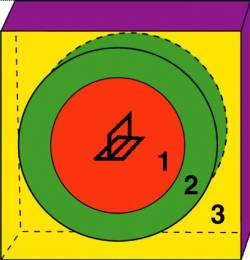Dallas R. Trinkle
Research Group
Flexible boundary conditions
 Simulations model atomic interactions. At the highest end of accuracy are density-functional (DFT) methods, which treat electronic bonding between atoms; with ab initio DFT methods, chemistry can be changed at will. However, calculations are often limited to 100-1000 atoms. To study defects, it's crucial to efficiently use electronic structure methods in the “core” of a defect and couple to computationally efficient methods away from the defect without corrupting the calculation. We develop approaches to extend that applicability.
Simulations model atomic interactions. At the highest end of accuracy are density-functional (DFT) methods, which treat electronic bonding between atoms; with ab initio DFT methods, chemistry can be changed at will. However, calculations are often limited to 100-1000 atoms. To study defects, it's crucial to efficiently use electronic structure methods in the “core” of a defect and couple to computationally efficient methods away from the defect without corrupting the calculation. We develop approaches to extend that applicability.
Lattice Green function
Typical DFT calculations require periodic boundary conditions, which often require very large computational cells for defect structures. This inefficiency can be resolved by using flexible boundary conditions that accurately feedback the correct long-range strain field of a defect. This method makes simulations of isolated defects with long-range strain fields possible with DFT. This requires the calculation of the lattice Green function (LGF) for a given geometry; the LGF determines the displacement for an infinite geometry—bulk or interface—in response to a point or line force. Hence, the full response of an “infinite” material can be efficiently determined for localized forces, such as at the core of a defect. This makes possible whole classes of simulations in a variety of materials from metals, to ceramics, to semiconductors—anything with long-range crystalline symmetry.
Publications
- “Lattice Green's function for crystals containing a planar interface”
M. Ghazisaeidi and D. R. Trinkle. Phys. Rev. B 82, 064115 (2010): publication, PDF, doi, preprint - “Convergence rate for numerical computation of the lattice Green's function”
M. Ghazisaeidi and D. R. Trinkle. Phys. Rev. E 79, 037701 (2009): publication, PDF, doi, preprint - “Lattice Green function for extended defect calculations: Computation and error estimation with long-range forces”
D. R. Trinkle. Phys. Rev. B 78, 014110 (2008): publication, PDF, doi, preprint
This work is funded by the NSF GOALI and NSF CAREER programs. Computational resources are provided through the Turing cluster at UIUC and the NSF TeraGrid program.
